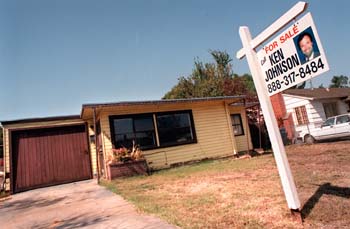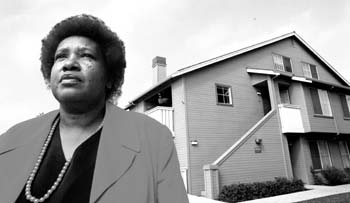![[Metroactive News&Issues]](http://metroactive.com/gifs/news468.gif)
[ San Jose | Metroactive Central | Archives ]
Surreal Estate: This small East Palo Alto home is currently under contract, according to its Realtor, for $250,000 as 'a major fixer-upper.'
Eastern Migration
Once, Silicon Valley stopped cold at the doorstep of East Palo Alto. Now, a spike in real estate values is revitalizing the community, but it is also driving out young African Americans.
By Michael Learmonth
WHEN AARON KOCH WAS A starving English major at Stanford University, the best apartment he could afford was two miles away across San Francisquito Creek in East Palo Alto. Not an unusual location for a Stanford student given local real estate realities, especially for one with a little courage and a high tolerance for squalor. His share of the rent, split with two friends, was $300.
"A big reason I moved there was because it was affordable," he says.
Koch soon graduated, landed a job in Assemblyman Ted Lempert's office and got married. He and his new wife, a teacher at Willow Oaks School in Menlo Park, looked all around the Peninsula for apartments they could afford. Not surprisingly, they ended up back in East Palo Alto in an $825 one-bedroom on the west side of 101.
"Anyone starting out with a starting salary is going to end up in East Palo Alto if they want to live on the Peninsula," he says.
But now that Koch and his wife are planning to buy a home, they intend to look in places few whites would have felt comfortable pouring their savings just a few years ago. They have come to regard East Palo Alto not as a stepping stone for lodging while they build their careers, but as a permanent home in which to invest and start a family. And while Koch says they plan to look in other areas--East Menlo Park, North Fair Oaks and Redwood City--he believes his best housing options remain in his adoptive city. And not just for economic reasons.
"We really like the multicultural community," he says. "There are more real people living here."
IF KOCH ACTS FAST, he could catch the front of a wave that East Palo Alto housing advocates say is already flooding the city with new residents. East Palo Alto, still a haven for working-class families, is experiencing gentrification on a scale as yet unseen.
Of course, during every job explosion in Silicon Valley this prediction is made. It only makes sense. Where else in the valley are three-bedroom ranch homes with decent acreage and easy access to 101 listing for less than $300,000?
But this time, the numbers are undeniable. Between December and June, sales ranged from the lowest, $160,000 for a three-bedroom on Pulgas Avenue, to the highest, $350,000 for a two-bedroom on O'Connor Street. Last year, property values in East Palo Alto rose 14.7 percent, the most of any city in San Mateo County. Menlo Park was second at 11.1 percent; Woodside third at 10.7 percent.
Real Facts, a company that collects rental market statistics for professionally managed apartment complexes of 50 units or more, used to completely ignore East Palo Alto. Until now.
"We were going to redline the whole city," says Caroline Latham of Real Facts. "But one of our major clients in Palo Alto turned out to own a building there."
Now collecting data, Real Facts shows an average rent for a one-bedroom apartment is $791, up almost $100 from a year before. The data, which exclude low-end and smaller buildings, also show an occupancy rate of 97.7 percent, just under that of prestigious Palo Alto.
"There are lots of predictions of great things in East Palo Alto," Latham says. "I'm sure the predictions will come true. It's just too good a location."
Color Guard: East Palo Alto resident Tiombe Jama stands in front of the Bay Oaks affordable housing complex which she feels has squeezed out African American tenants.
WHILE REAL ESTATE speculators salivate, long-term residents of the city are watching their community change before their very eyes. East Palo Alto became an African American community when machinists, mechanics and draftsmen, who had developed their trades at Bay Area military installations, moved to East Palo Alto at the end of World War II. Always more isolated and close-knit than Richmond or Oakland, East Palo Alto was dramatically affected by the collapse of the blue-collar job market in the 1960s. When the African American labor force didn't adapt to the emerging high-tech industrial economy, East Palo Alto gradually became notorious for crime, violence and poverty. But amid the city's troubles, an activist community has always thrived, once leading a movement to change the name of East Palo Alto to Nairobi.
Over the years, the city has gradually changed color. William Webster, chairman of the East Palo Alto Rent Stabilization Board, notes that the largest single ethnic group in the city is now Latino, but even that is in transition. He predicts that the influx of working-class Latinos into apartment complexes and into single-family homes is a temporary phenomenon. The ethnic future of East Palo Alto, he believes, is Asian and white.
"From a financial standpoint, East Palo Alto is being gentrified," he says. "It's only a matter of time before the demographics catch up with the economic situation. It's very sad."
Accelerating East Palo Alto's integration into Silicon Valley's explosive housing market is Assembly Bill 1164, which took full effect Jan. 1. The Costa/ Hawkins Rental Housing Act, as it is known, weakens one of the state's strongest local rent-control ordinances. The act, targeted at the rent-control cities of East Palo Alto, Berkeley, Santa Monica and Cotati, allows landlords to raise rents to whatever level they believe the market will bear as soon as they become vacant. In the past, rent increases were capped even when a unit changed tenants.
As rents climb, the most visible exodus from the city is that of young African Americans.
"The younger [African Americans] are living with parents and grandparents," Webster explains. When a grandparent dies or a house is sold it is typically purchased by a Latino buyer, sometimes pooling the resources of several families. Older African Americans who sell are typically retirees who leave California for the Deep South or Texas. Younger African Americans try to re-establish themselves in the Central Valley.
"East Palo Alto has had generations of families. Some have four generations," Councilwoman Myrtle Walker says. "Young people are moving from East Palo Alto to Stockton and Modesto. It's really hurting the family cycle."
It's a personal phenomenon for Walker. Her son, Tony Walker, 32, picked up his wife and two daughters and moved to Modesto four months ago.
Before he moved, he lived in an apartment in East Palo Alto. The rent was $850 and climbing.
Now he has a two-bedroom house in Modesto and pays $700 a month.
"The reason I moved is I couldn't afford it anymore," he says. "All my friends have moved to Sacramento and Stockton. Unfortunately, if you didn't graduate from college, you can't live around East Palo Alto."
The move would have been easier if he were going to a place where his skills were more in demand. Unfortunately, his job at Kohlwiess Import Auto Parts in Redwood City didn't move with him.
"I get up at four in the morning to be here by 8am," he says. "It's taken a toll on my kids. Eventually, I'm going to have to figure something out. Over there it's hard to find a job for more than $8 or $9 an hour."
Myrtle Walker worries about the time--four to five hours a day--that her son spends on the road.
"I hear from my constituents that their kids will never be able to buy a house in East Palo Alto," she says. "My son says he encounters road rage, auto accidents. That's an extra stress being placed on our younger generation who are trying to do the right thing by having a job and working to support our families."
For a time, Tony Walker's wife held a Section 8 certificate from the San Mateo County Housing Authority. But as rents climb, landlords willing to accept certificate-holders are harder to find.
"Landlords are not eager to deal with someone getting a subsidy," says Calvin Whitaker, East Palo Alto housing director.
But as housing activist Tiombe Jama eagerly points out, East Palo Alto residents aren't the only ones who need a housing subsidy on the Peninsula.
"When the police chief in Atherton has to get a subsidy to get a house, that's welfare," she says. Jama, who has lived in East Palo Alto for 23 years, recently formed a group she calls Coalition for Housing Retention and Displacement Prevention.
"East Palo Alto is a beautiful place," she says. "I've spent my life building it up. Now it's like the little red hen: We baked the cake and someone else wants to eat it up. I'm so upset!"
All she wants, she says, is for everyone to be able to have a home in the area. To make her point, she likens shelter to another necessity that everyone, regardless of income, ought to be able to buy locally.
"I can eat broccoli," she says, "I might not buy it at Andronico's, but I can buy it at Lucky's. It has to be the same for housing."
[ San Jose | Metroactive Central | Archives ]
Copyright © 1999 Metro Publishing Inc. Metroactive is affiliated with the Boulevards Network.
For more information about the San Jose/Silicon Valley area, visit sanjose.com.
![]()

Photograph by George Sakkestad

Photograph by George Sakkestad
From the September 30-October 6, 1999 issue of Metro, Silicon Valley's Weekly Newspaper.